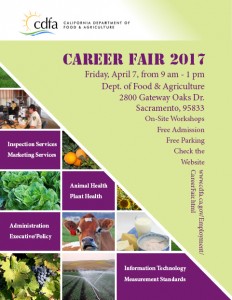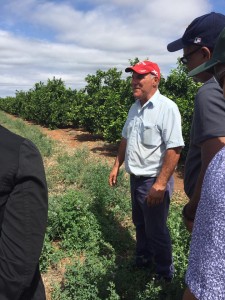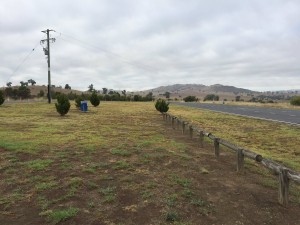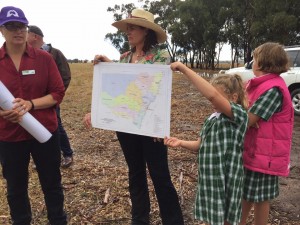
Rich Collins of Dixon provides opportunities for several small farmers by leasing them acreage to produce crops such as hops and organic mixed vegetables. Photo/Bob Johnson
By Bob Johnson
A few hundred yards from the Kidwell Road off ramp from Highway 80 heading into Dixon from the east, Rich and Shelly Collins have built a small incubator for farmers who serve the local community.
Emma Torbert has four acres of tree fruit for U-pick customers, or for sale through her community-supported agriculture operation, Cloverleaf Farms. Jan-Erik Paino grows five acres of hops he trucks over to Sacramento for his Ruhstaller Brewery, where the slogan is “we grow beer.” Jason Cuff and Glen Baldwin are planting eight acres of organic mixed vegetables they plan to sell at the farm stand on the property.
This location, with the small barn-red farm stand visible from the highway, is what Rich Collins calls an edge, one of the meeting places of the urban and the rural he believes are at the heart of agritourism, and of farming itself.
“At these edges, farm producers and consumers can look into each other’s worlds,” Collins said. “If your connection to the edge is inadequate, you will not know what your consumers want.”
He made his comment during the Yolo, Sacramento, Solano Agritourism Summit in Davis, sponsored by the University of California Small Farm Center.
The summit, one of four held throughout the state, brought together farmers, university researchers, land use regulators and local tourism agency representatives, to meet and share insights on how farmers can make a few extra dollars by inviting in people from the local community.
“Experience is a pretty perishable product, so that means the businesses that can provide it are not as perishable,” said Collins, who is chairman of the board of the Community Alliance with Family Farmers. “The experience has to be authentic. Today’s consumer is ripe for that experience.”
Thousands of farmers are making anywhere from a little to a lot of their budget by inviting the public to their farm, ranch or winery to buy the products, and to experience where they are produced.
“Most of them are making between $5,000 and $25,000 from their agritourism activities,” said Penny Leff, UC Small Farm Program agritourism coordinator. “It’s not a lot of money, but it’s a nice supplement to farming income. A few of them are making millions on their agritourism; a small number of them get 25,000 visitors a year.”
Wineries lead the way in agritourism, there are 2,000 to 3,000 tasting rooms in the state, but producers of all sorts of fruits, vegetables and proteins are taking advantage of this opportunity.
“When people come out to your farm or ranch for an experience, they’re still going to buy things,” Leff said. “You may be able to charge a little more, and you’re going to send them home feeling better about the experience.”
Leff, who works extensively with UC Cooperative Extension advisors to help develop local agritourism, introduced the summit attendees to Yolo, Solano and Sacramento counties small farm advisor Margaret Lloyd, who also specializes in organic mixed vegetables out of the Woodland office.
The Small Farm Center also maintains a library of webinars on subjects of interest to agritourism on its webpage (sfp.ucdavis.edu/agritourism/).
“When you do agritourism, you are in the hospitality business,” Leff said. “You need different skills, and maybe different employees, have to have different insurances, and deal with different governmental and community groups.”
The local planning department can be among the more difficult governmental agencies faced when developing an agritourism business.
“We’re the biggest challenge and the least helpful,” said Taro Echiburu, director of the Community Services Department in Yolo County. “Regulators are there to implement policies that are set by others. I believe we can be helpful by getting out of the way and letting the market take over, and by making sure it doesn’t get out of control.”
Collins navigated his way around tough building standards at his Dixon farm by limiting himself to a postage stamp-sized farm stand.
“We have a 120-square-foot farm stand at the exit,” he said. “We made it 120 feet because that is the largest structure you can build without a permit. If it were 121 feet, it would cost $100,000 to build.”
Since he set out to try his hand at vegetable growing, Collins has had to learn about a lot of things other than farming.
“I got my start in endive in 1978, and went commercial in 1983,” he recalled. “I quickly found out that growing endive was one challenge, but another was selling it, because nobody knew what it was or how you used it. When I was 18, I was production oriented. But the day after I had my first box, I had to figure out how to sell it.”
Collins started California Endive Farms in the 1980s and by the time he sold it a few years ago to concentrate on his farm stand and incubator, the company had grown to be easily the largest endive producer in the country.
“Start with a market and work backwards,” he advised. “Just because you can produce it doesn’t mean you’re going to be able to sell it and market it at a profit. Consumers are the suppliers of demand.”
He said what he believes many people want today is a meeting at the edge with their farmers, so they can experience the place their food is produced.
Link to Ag Alert and the California Farm Bureau Federation















